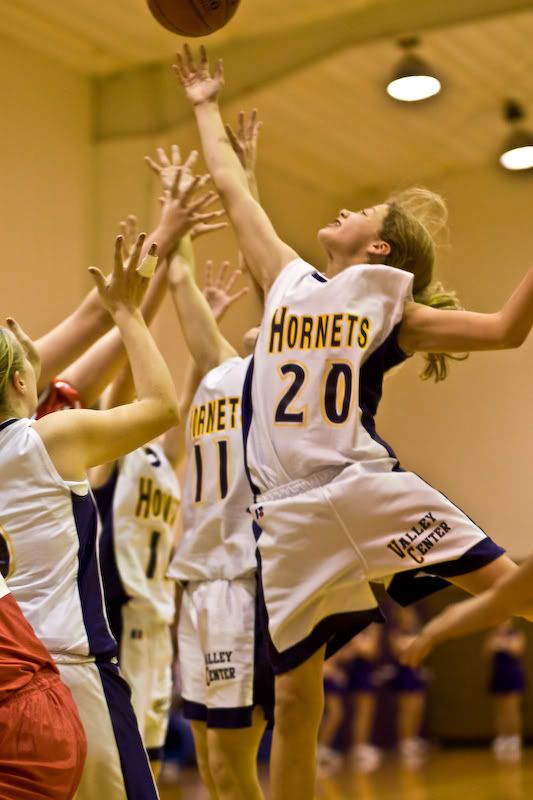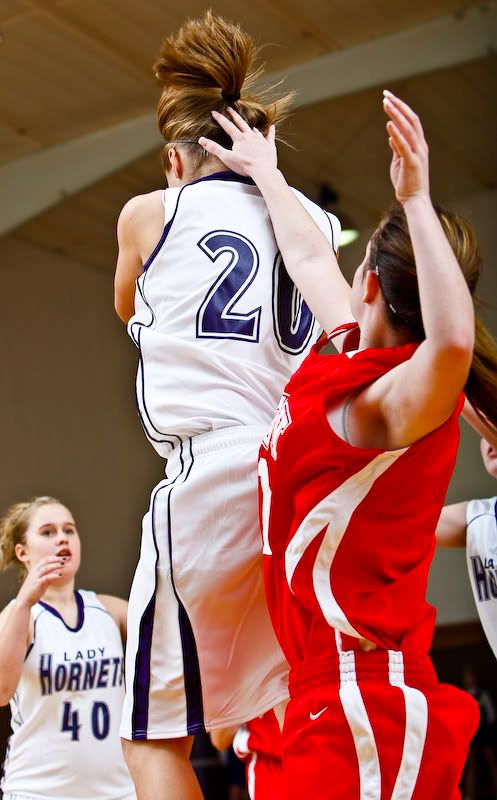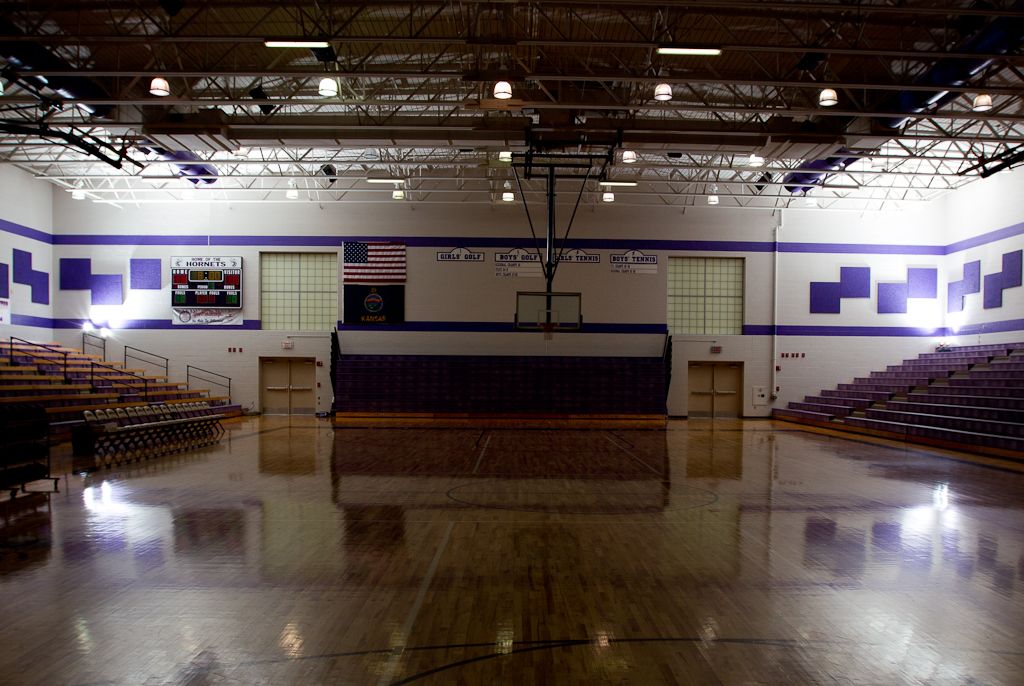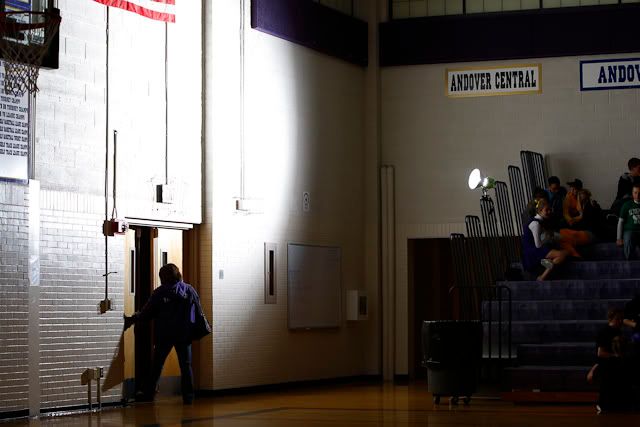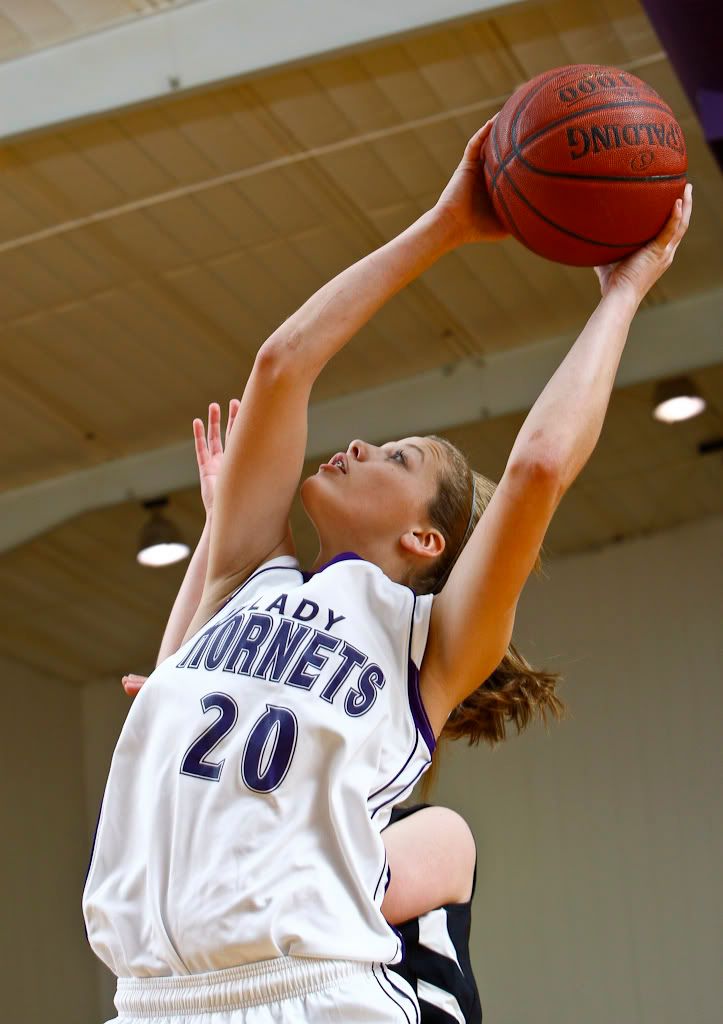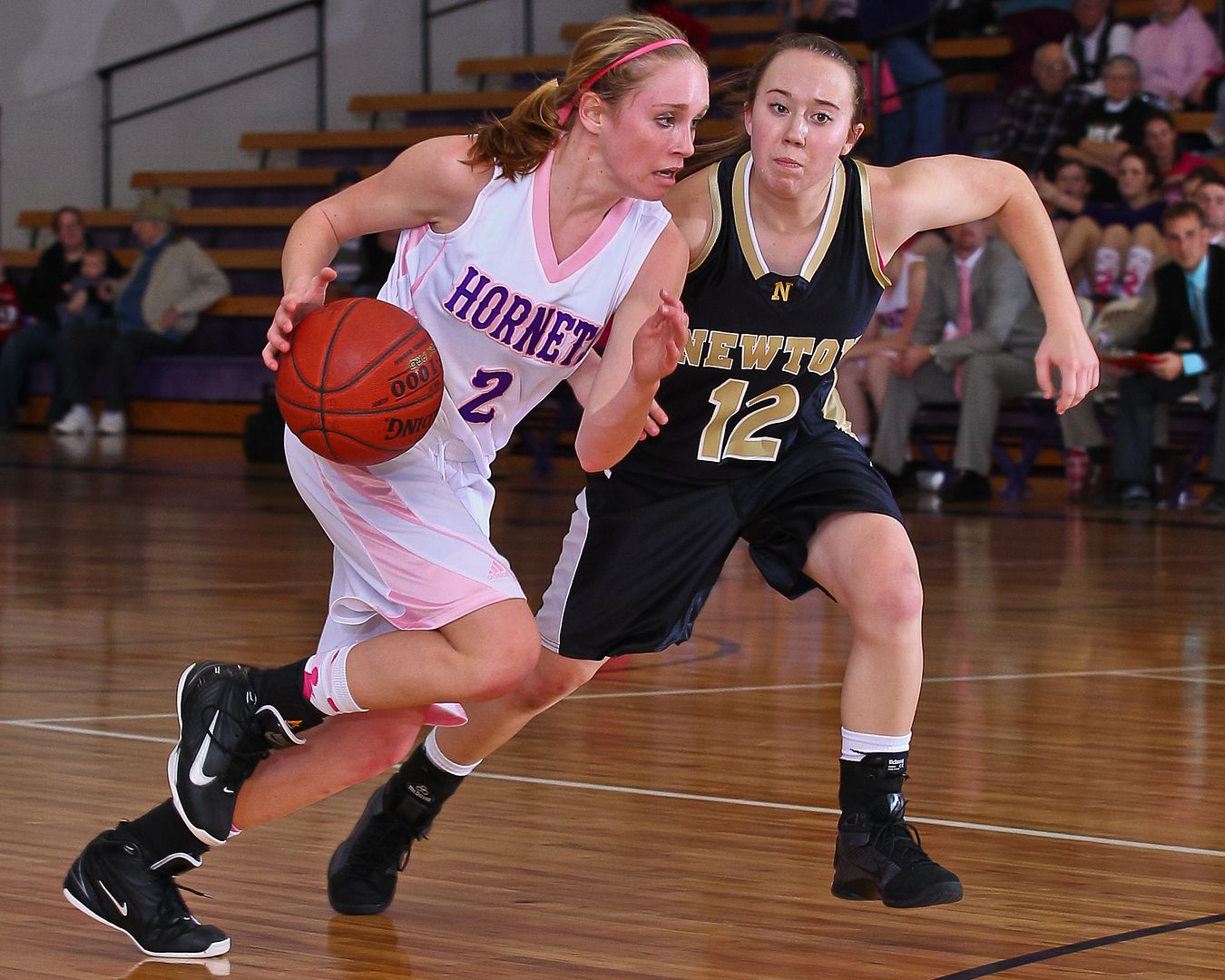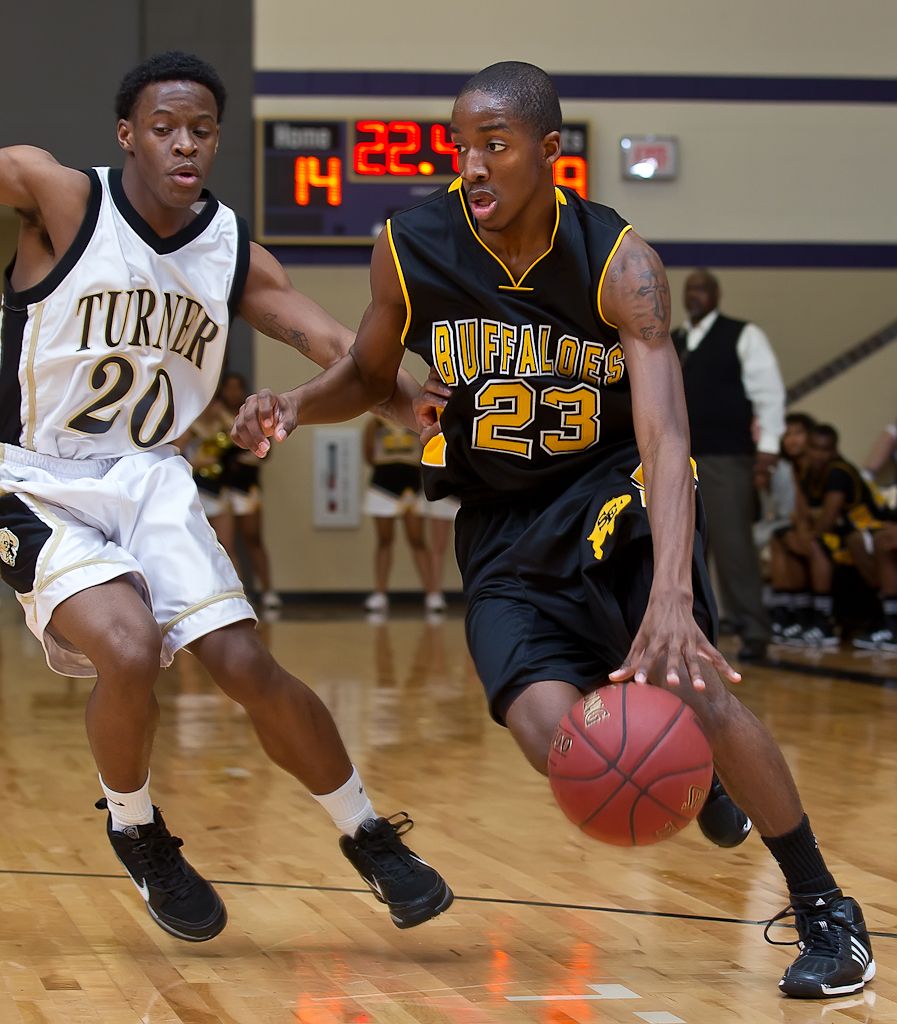Strobing High School Basketball
Lighting in high schools gymnasia is quite variable. Older facilities can be very dark and the spectra of light emanating from the fixtures can be of poor quality. Skin tones may be jaundiced to an extent that they cannot be fully corrected in post production. The spectra are often too saturated in yellow and under represented in red. Even if the color levels are reverse engineered in post (extra red, reduced yellow saturation) the image quality never really improves to a satisfactory level.
When I first started shooting in 2007, I purchased a 1D III in an attempt to use a good body to fix bad light. The following light is bad, bad, bad. The wall actually looked that awful to the naked eye. The red and green colors were not a transitory illusion.
Even with a fine 1D III camera body, the IQ was awful.
There is no amount of post production that can save that image. It can't be done.
This shot was taken a year later. It's from the same gym, exactly the same spot, same daughter, same opposing team and same camera. The difference was the light from two Alien Bee B800s bounced off the ceiling.
The improvement in colors and skin tones is undeniable.
At this point, it is important to note the good news. There are several factors acting to improve the IQ (image quality) for photographs taken with ambient gym light. The need for more efficient lighting, driven by tight budgets and government regulations, has created improved illumination for middle and high schools across the US. The improvement has been in both quality and quantity. Modern camera bodies have also improved. It is no longer unusual to see images taken at ISO 6400 that are excellent. Processing software has noise reduction features that are wonderful. Lightroom and Photoshop are very good at NR and Noiseware is terrific. However, there are still some facilities that retain the old, dark, buzzy, off color light that just can't be fixed.
The answer for those gyms is supplemental lighting. Here, I'll address strobing.
Some shooters use speed lights and regardless of the supplemental source, that source can be used as a direct light or bounced off the ceiling or wall. My work is done using bounced strobes (Alien Bee B800s). Strobes are usually much more powerful than speed lights. Bouncing reduces the reflected light by about a stop compared with direct light. Direct light gives more shadows than indirect. Some people prefer the look of direct. It is a matter of personal choice.
Location
The favored location for the lights (usually 2) is to have one light near each corner of the gym on one end of the court.
Here a total of 4 lights, two in each corner, were used.
Use the KISS principal. Keep It Simple and Symmetrical.
Symmetry is the best way to avoid having bright and dark areas on the gym floor. Uniform light levels (for the front court) will eliminate any need to adjust exposure on the run during game action. Sometimes the wall is so close to the end line that it is difficult or impossible to bounce off the ceiling. In those cases, just bounce off the back wall.
Keep the light at your back. That is, shoot from behind the baseline. Aim the lights to hit the ceiling on a line to bounce toward the top of the key. The ideal quality check is to walk the front court with a light meter to aid in the aiming of lights and to even out the light levels.
Power
Strobes should be at full power for bounced flash. Best results will be obtained when the light is 3 stops above ambient or more. Alien Bees will have shorter flash times at full power than they do when set at lower levels. That's right. All though it seems counterintuitive, full power means short duration. Speedlights are the opposite. More power + short duration = Good IQ. If you are less than 3 stops above ambient, your pictures will tend to have increasing amounts of ghosting from the ambient light. Since most strobed images are shot at 1/250 or other max sync speed, any ambient light will reveal motion blur. Strobed light won't because the flash will be about 1/1000 seconds long. See manufacturers specs.
Strobes have much more power than speed lights but they require a power source. That means either access to an electrical outlet (and therefore a possible trip hazard) or a battery pack of some sort.
Triggers
Triggering remote strobes can be done with cords or wireless radio. Cords are often problematic because of the distances involved and the potential trip hazard. There are several radio triggers available at widely differing prices. I use Pocket Wizard units. They are the gold standard for reliability and range. The sending unit is mounted on the camera hot shoe and the receivers are at the strobes.
As you can tell, strobing requires a lot of work and a lot of gear. You will need lights, radio receivers for each light, appropriate cords, a radio sending unit for your camera body, clamps or lightstands for each light, and provisions for power cords or battery packs. Shooting strobes eliminates burst shooting because of recharge time. For my B800s, that means about one shot every 1.2 seconds. Ambient shots are much easier to get. However, when you are in a dark gym and you want the best quality, strobes are unbeatable.
My daughter in 8th grade. 1/250 sec, f/6.3, 70mm ISO 640. Canon 1D Mark III, Canon EF 70-200mm f/2.8L IS. I've got a 20-30 standout print of this image. The detail is so good that one can count the stitches on her jersey and the dimples on the ball.
1/250 sec, f/5.6, 70mm, ISO 800, Canon 1D Mark IV, Canon EF 70-200mm f/2.8L IS
The isolation provided by light fall off is a plus. With strobes, you can shoot at f/4.0 with no problems. The larger dof from smaller apertures give more focus leeway and increased sharpness. The lower ISOs used mean more detail and less noise. White balance problems from light cycling are non-existent. There is a lot to be said for the image quality available from strobed images.
1/250 sec, f/4.0, 70mm, ISO 400. Canon 1D Mark IV, Canon EF 70-200mm f/2.8L IS
The lighting improvements mentioned at the beginning of this blog has greatly reduced the amount of strobing that I do. However, strobed images still set the standard for IQ and have an important place at venues with poor light.
Phil Zivnuska

